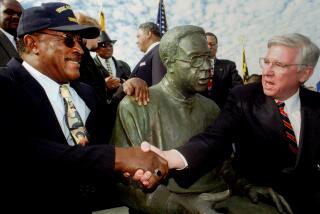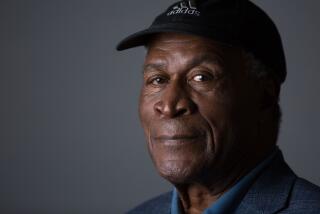‘AMOS, ANN’: LAMPOONING SEXUAL POLITICS
- Share via
Tony Barsha’s “Amos and Ann,” at the Wallenboyd, is unyielding in its male perspective. Yet women, as much as men, may appreciate the glee with which “Amos” dismembers the sexual politics of the 1958-60 period in which it’s set.
It’s the story of Amos, a middle-aged Laguna Beach contractor who offers his experiences as a cautionary tale for young men who foolishly endeavor to understand women. The subtitle is “A Lesson in the Ways of Love,” but the question soon arises: What’s love got to do with it?
Ann, a waitress whom Amos picks up one fateful evening, may believe she loves Amos, but in fact she loves Doris Day movies, and wishes she were in one. Though she sleeps with Amos, her attitude toward sex is reflected in her refusal to take off her bra in bed.
The “other woman,” a beatnik whom Amos calls Mona, doesn’t wear a bra. She’s as obsessed with showing off her breasts as Ann is with hiding hers--she even wants to turn toplessness into a business. All the same, Mona prefers talking about sex to doing it.
Ann and Mona are cartoon characters, seen through the eyes of Amos, who is presented as a genial if obtuse guide. This takes him off the hook too easily. The play would be stronger if Barsha paid more attention to why Amos behaves as he does--including his sudden conversion to a more bohemian way of life, halfway through the play.
It’s also unfair for Amos to remain clothed while the women are half-dressed throughout much of the play, especially when Barsha makes such a big deal out of Ann’s refusal to strip even further.
Still, as a director Barsha has drawn considerable amusement from his dark little cartoon. Pamela Hayden’s Ann is a remarkable creation. Although she looks at Amos as he speaks, she addresses most of her responses to the fourth wall, the better to control the scenario she’s playing out in her mind. When she loses that control, watch out.
Honey Goldberg’s Mona is even funnier, though not as fully drawn as Ann. As Amos, Peter Lownds affects a down-to-earth, no-jive style that provides a striking contrast to the vacuity of what he actually says. Yet he’s unable to fill in the details about this man that Barsha left out--partially because he appears a few years too young for the role.
The lighting design by Jason Berliner and Alex Wright skillfully hones the play’s contours. The sound design is equally detailed but not quite as precise.
Performances at 301 Boyd St. are at 8 p.m. Fridays and Saturdays through Oct. 4; (213) 629-2205.
More to Read
The biggest entertainment stories
Get our big stories about Hollywood, film, television, music, arts, culture and more right in your inbox as soon as they publish.
You may occasionally receive promotional content from the Los Angeles Times.










